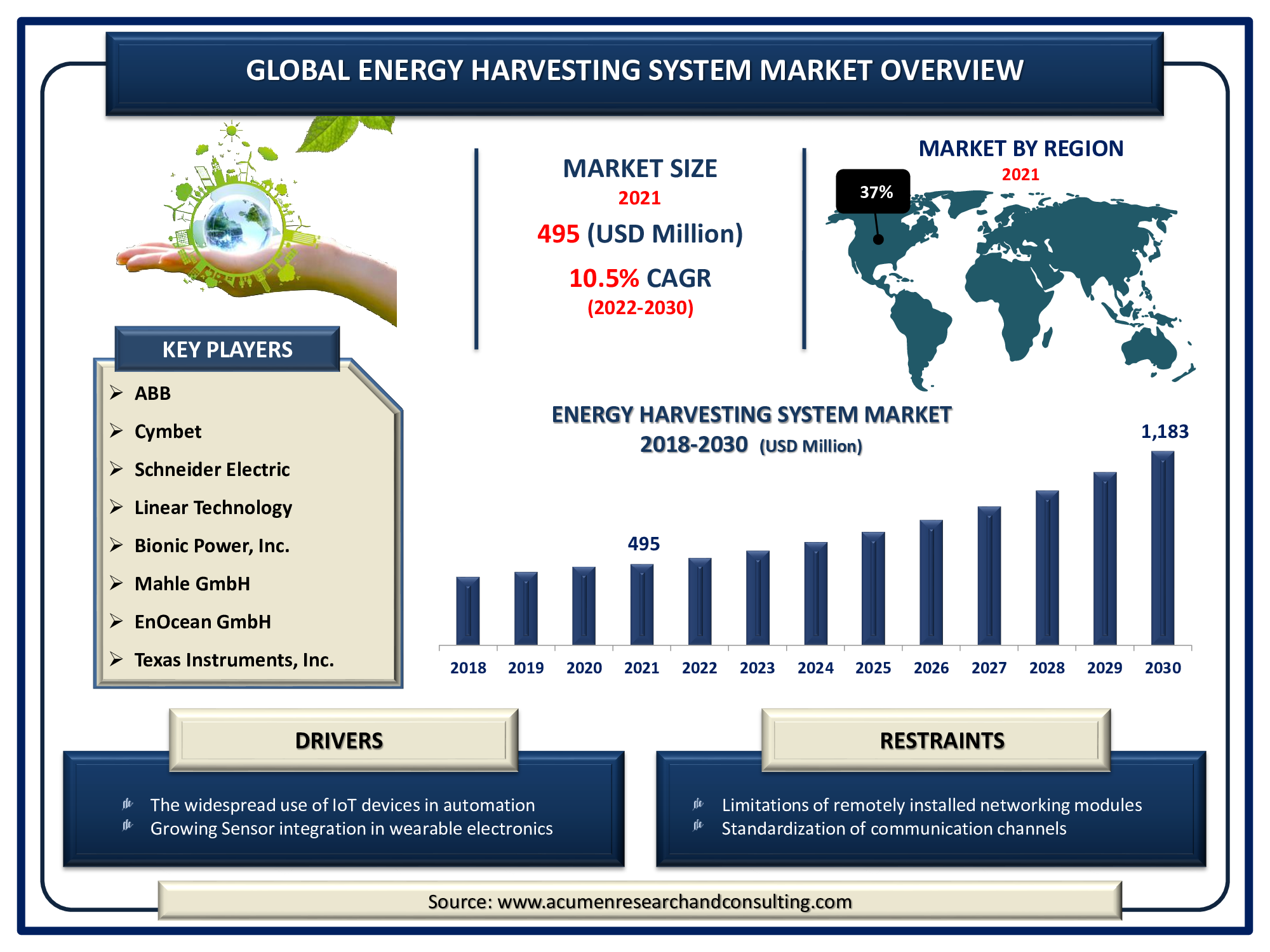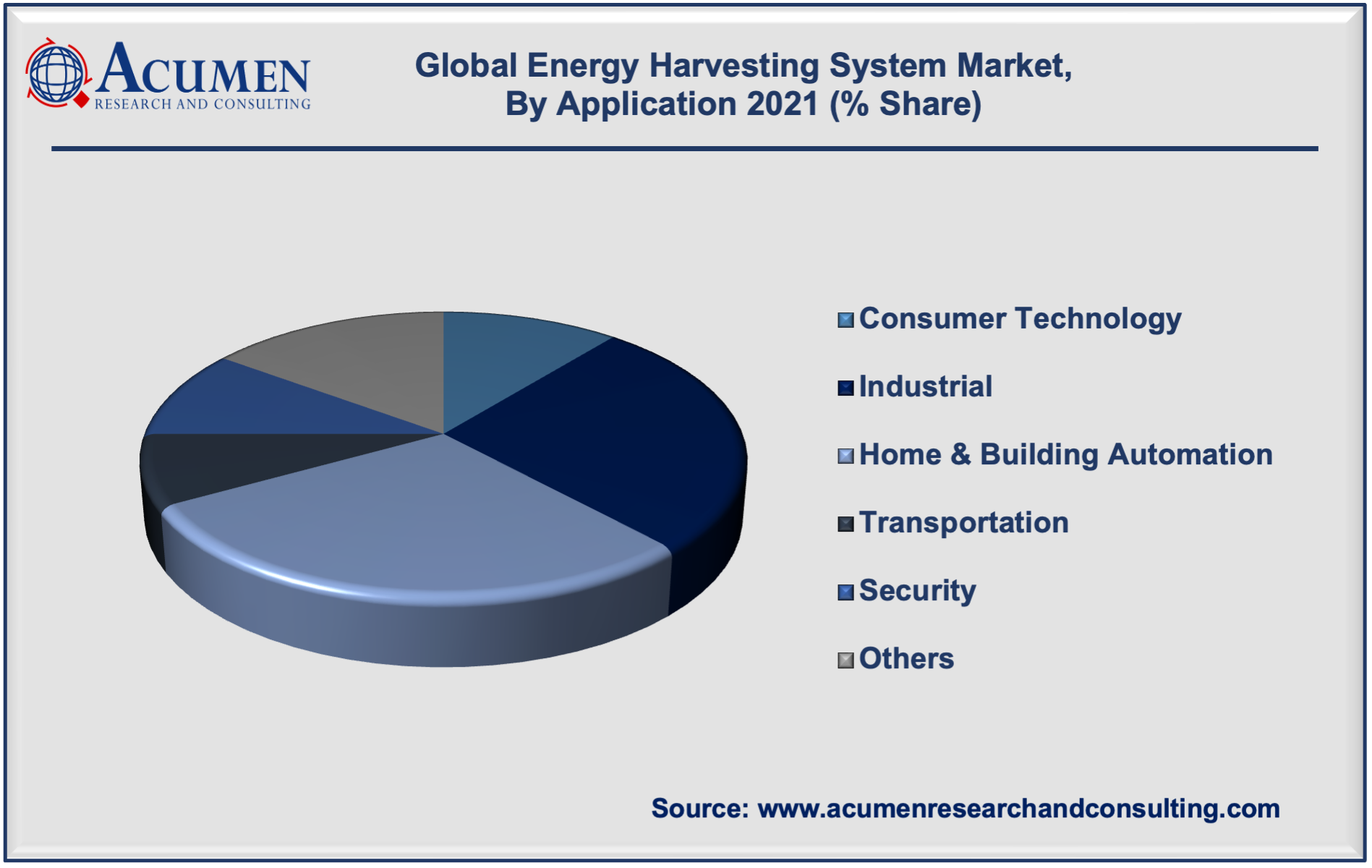January 2021
Energy Harvesting System Market is expected to reach USD 1,183 Mn by 2030 with a considerable CAGR of 10.5%
The Global Energy Harvesting System Market size accounted for USD 495 Mn in 2021 and is expected to reach USD 1,183 Mn by 2030 with a considerable CAGR of 10.5% during the forecast timeframe of 2022 to 2030.

The process of collecting and converting energy from the environment into electricity is known as energy harvesting, also known as energy scavenging or ambient energy. Energy harvesting catches little amounts of renewable energy that would otherwise be lost as vibration, heat, light, and other waste. Such energy can be harnessed continuously or conserved to be used afterward. Energy harvesting as a technology is still in its early phases of development, but it is far from a solution to our energy problems. However, it has enormous potential for powering low-power gadgets. Also, the energy harvesting system market has benefited from the fast-increasing internet of things (IoT) marketplace approach.
Global Energy Harvesting System Market Dynamics
Drivers
Restraints
Opportunity
Report Coverage
| Market | Energy Harvesting System Market |
| Market Size 2021 | US$ 495 Mn |
| Market Forecast 2030 | US$ 1,183 Mn |
| CAGR | 10.5% During 2022 - 2030 |
| Analysis Period | 2018 - 2030 |
| Base Year | 2021 |
| Forecast Data | 2022 - 2030 |
| Segments Covered | By Technology, By Component, By Application, And By Geography |
| Regional Scope | North America, Europe, Asia Pacific, Latin America, and Middle East & Africa |
| Key Companies Profiled | ABB, Cymbet, Schneider Electric, Linear Technology, Bionic Power, Inc., Mahle GmbH, EnOcean GmbH, Texas Instruments, Inc., Powercast Corp., STMicroelectronics, Analog Devices, Inc., and Convergence Wireless. |
| Report Coverage |
Market Trends, Drivers, Restraints, Competitive Analysis, Player Profiling, Regulation Analysis |
| Customization Scope |
10 hrs of free customization and expert consultation |
The widespread usage of IoT devices in automated processes, the rising demand for energy-efficient and sustainable approaches, and the abundance of alternative energy sources such as tidal, ocean, and wind energy are all contributing to the growth of the energy harvesting system market. Growing government expenditure on infrastructure and industry growth, higher knowledge of environmental energy trends, and favorable government efforts to limit CO2 emissions from structures are all expected to enhance the energy harvesting system's market shares. Furthermore, favorable socio-demographic and economic factors such as population growth, urbanization, consumer spending, and higher living standards, in combination with significant advancements in commercial aspects, are responsible for driving global energy harvesting system market trends.
Aside from that, factors such as a lack of standards and procedures, as well as the limitations of remotely deployed connectivity modules, limit the market growth.
Energy Harvesting System Market Segmentation
The global energy harvesting system market segmentation is based on technology, component, application, and region.
Market by Technology
In terms of technology, the light segment held the largest market share in 2021. The market for light energy harvesting is expanding due to improved photovoltaic module efficiency and the manufacture of solar-based technologies. Solar energy is a widely accessible and natural form of energy that can be easily transformed into electricity. Also, the number of key players involved in the production of solar energy-based products categorized as part of the light energy harvesting sector is increasing. This harvested energy is then used effectively in industry sectors such as smart buildings and consumer electronics. Furthermore, the vibration-based energy harvesting system will have the second-largest market share due to the use of piezoelectric transducers in a wide range of applications in the public transportation and construction industries. This trend is effectively increasing the global energy harvesting systems market revenue.
Market by Component
In terms of components, the sensor segment will have the largest market share in 2021. Sensors are integral elements of an energy conversion system. They are responsible to collect and transforming different lighting sources, temperature fluctuations, kinetic motion, and pressure changes into energy. Furthermore, during the forecast period, the transducer market is expected to grow significantly. The energy harvester is the transducer, which collects and converts the energy from the source into electric power. Some common transducers used in industry include photovoltaic transducers for light, inductive transducers for magnetic fields, thermoelectric transducers for heat, RF transducers for radio waves, and piezoelectric transducers for vibration modes of energy.
Market by Application

Others Based on the application, the industrial segment is expected to grow significantly in the market over the next few years. Energy harvesting systems in industrial applications collect and transform ambient spinning, shaking, and vibration from structural components to generate electricity. Industrial applications are expanding as IoT technology evolves. In most industrial settings, machinery provides inherent sources of energy with thermal and vibration, as well as many other movements for electrodynamic and electromagnetic power conversion techniques. Such applications effectively improve the performance and productivity of industries and drive the market.
Furthermore, due to the expanding building infrastructure industry and the growing development of advanced sensor connectivity and the Internet of Things (IoT) for building automation, security, and electronic systems, the building & home automation segment is expected to grow at a faster rate over the forecast period. Furthermore, rising solar technology manufacturing for household appliances, smart buildings, and security monitoring solutions in buildings is expected to drive market growth over the forecast period.
Energy Harvesting System Market Regional Overview
North America
· U.S.
· Canada
Europe
· U.K.
· France
· Germany
· Spain
· Rest of Europe
Latin America
· Mexico
· Brazil
· Rest of Latin America
Asia-Pacific
· India
· China
· Japan
· Australia
· South Korea
· Rest of Asia-Pacific
Middle East & Africa
· South Africa
· GCC
· Rest of Middle East & Africa
The North America region accounted for a significant market share in the global energy harvesting system market due to rapid technological advancements in the field of energy harvesting and investments in IoT technology. These technologies are gaining popularity in North America as an alternative energy source. Current technological innovations in the region have become an important factor in the growth of this system for construction and home automation investments. Furthermore, the United States has been the dominant country in North America due to the greater adoption of energy harvesting systems in Smart buildings and household appliances. Renewable energy production has also increased in the region. This market has also expanded the country's automotive and construction sectors. All of these factors have contributed to the United States being the world's major industry for energy harvesting systems.
Energy Harvesting SystemMarketPlayers
Some of the prominent players in global energy harvesting system market are ABB, Cymbet, Schneider Electric, Linear Technology, Bionic Power, Inc., Mahle GmbH, EnOcean GmbH, Texas Instruments, Inc., Powercast Corp., STMicroelectronics, Analog Devices, Inc., and Convergence Wireless.
Looking for discounts, bulk pricing, or custom solutions? Contact us today at sales@acumenresearchandconsulting.com
January 2021
June 2021
February 2023
April 2020